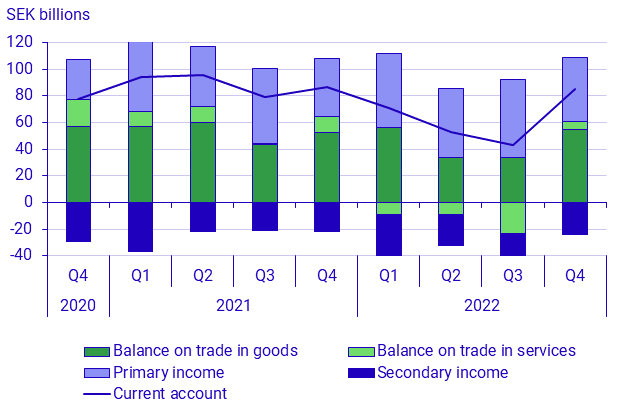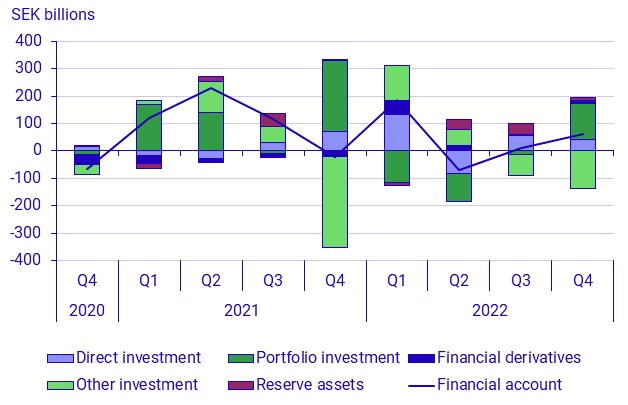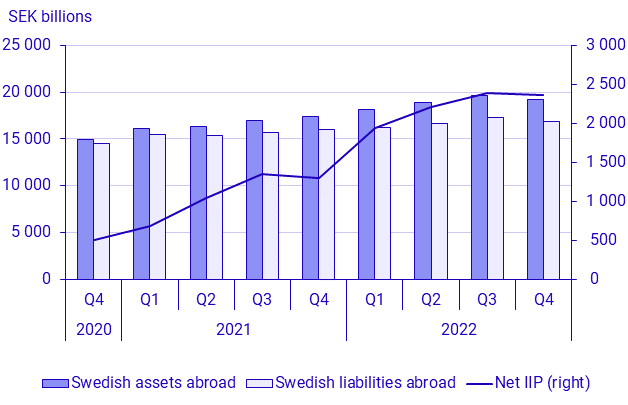Balance of payments, 4th quarter 2022
Strong trade in goods and services in the fourth quarter
Statistical news from Statistics Sweden 2023-03-06 8.00
The current account surplus amounted to SEK 85.0 billion during the fourth quarter of 2022. Both exports and imports of goods and services showed large increases compared to the fourth quarter of 2021. The development for exports is equivalent to imports, which leads to that the current account surplus is at the same level as the corresponding quarter of previous year, when it amounted to SEK 86.5 billion.
“The current account surplus decreased by SEK 1.5 billion. This leads to that the current account balance is relatively unchanged compared to the fourth quarter of 2021.” says Linda Nihlwing, economist at the Balance of Payments unit.
Sweden’s net external assets position amounted to SEK 2 356.7 billion at the end of fourth quarter of 2022. The financial account shows that net lending with the rest of the world amounted to SEK 59.8 billion during the same quarter.
What is the balance of payments?
The balance of payments is a statement of all Swedish transactions with the rest of the world. It presents exports and imports of goods and services. It also includes a description of changes in financial assets and liabilities with the rest of the world. The balance of payments consists of the current account, the financial account, and the capital account. The component parts of the balance of payments and related terms are explained under Definitions and explanations, at the end of this item of statistics news.
Current account surplus as share of Sweden’s GDP
In the fourth quarter of 2022, Sweden’s current account as a share of GDP amounted to 4.3 percent of Sweden’s GDP, calculated as a moving average over the last four quarters.

Comparisons between periods in the current account are made using the corresponding quarter the previous year.
Both exports and imports of goods and services increased
Trade in goods showed a surplus of SEK 54.9 billion in the fourth quarter of 2022. This is an increase of SEK 2.5 billion compared with fourth quarter of 2021. Exports of goods amounted to SEK 590.5 billion, which is an increase of SEK 95.7 billion compared with the corresponding quarter a year ago. Imports of goods amounted to SEK 535.6 billion, up by SEK 93.2 billion in a corresponding comparison.
Surplus in merchanting, which is included in the balance on trade in goods, increased by SEK 10.6 billion compared with the fourth quarter of 2021. The surplus thus amounted to SEK 54.1 billion in the fourth quarter of 2022.
Trade in services noted a surplus of SEK 5.8 billion. This can be compared with a surplus of SEK 12.1 billion in the corresponding quarter last year. Imports of services amounted to SEK 274.9 billion, up by SEK 59.8 billion compared with the fourth quarter of 2021. At the same time, exports of services noted an increase of SEK 53.4 billion in a corresponding comparison and amounted to SEK 280.6 billion.
Primary income surplus widened
Primary income, which consists mainly of compensation of employees and investment income, presented a surplus of SEK 48.0 billion in the fourth quarter of 2022. The surplus widened by SEK 4.6 billion compared with the corresponding quarter a year ago. Investment income is the main part of primary income that contributed to this change through an increased surplus. The surplus in investment income went from SEK 42.6 billion in the fourth quarter of 2021 to SEK 46.6 billion in the fourth quarter of 2022.
Portfolio investment contributed a surplus of SEK 7.8 billion to investment income, an increase of SEK 4.3 billion compared with the corresponding quarter a year ago. Investment income on direct investment contributed a surplus of SEK 43.3 billion, which is an increase of SEK 2.4 billion in a corresponding comparison.
Secondary income deficit widened
Secondary income, which includes international cooperation and donations and contributions to the EU, presented a deficit of SEK 23.7 billion. This deficit increased by SEK 2.3 billion compared with the corresponding quarter a year ago.
Net lending in the financial account
The financial account presented net borrowing amounting to SEK 59.8 billion in the fourth quarter of 2022. Net lending and net borrowing refer to the overall balance on the financial account.
During the fourth quarter direct investment, portfolio investment, financial derivates and reserve assets showed net lending. Other investment showed net borrowing during the same quarter.

Direct investment increased both in Sweden and abroad
Net lending in direct investment amounted to SEK 42.5 billion during the quarter. Foreign direct investment in Sweden increased by SEK 220.9 billion and Swedish direct investment abroad increased by SEK 263.4 billion.
Portfolio investment decreased in Sweden and increased abroad
Net lending in portfolio investment amounted to SEK 130.2 billion during the quarter. Foreign investors decreased their portfolio investment in Sweden by SEK 105.6 billion, and Swedish investors increased their portfolio investment abroad by SEK 24.6 billion.
Other investment decreased in Sweden and abroad
Net borrowing in other investment corresponded to SEK 135.7 billion. Swedish other investment abroad decreased by SEK 463.0 billion, and foreign other investment in Sweden decreased by SEK 327.3 billion.
Financial derivatives and reserve assets
Net lending in financial derivatives and reserve assets amounted to SEK 10.9 billion and SEK 11.9 billion, respectively.
Net assets in Sweden’s international investment position decreased
Sweden’s net external assets position amounted to SEK 2 356.7 billion, which is a decrease compared with SEK 2 391.6 billion in the previous quarter.

Swedish external assets and liabilities decreased
During the fourth quarter, Swedish external assets amounted to SEK 19 237.8 billion, a decrease of SEK 437.2 billion compared with the previous quarter. Swedish external liabilities decreased by SEK 402.3 billion compared with the previous quarter and amounted to SEK 16 881.1 billion.
Direct investment and portfolio investment increased both in Sweden and abroad. Other investment and financial derivates decreased both in Sweden and abroad. Reserve assets decreased abroad.
The largest net external assets were in reserve assets and direct investment.
Revisions
The Balance of Payments adheres to a predetermined revision policy, see Section 2.3 in the 2022 Quality Declaration.
Kvalitetsdeklaration, Betalningsbalans och utlandsställning, 2022 (scb.se)
The time series for the Balance of Payments and the International Investment Position has been revised from Q1 2015. The revision period has been extended due to the implementation of new sources of personal transfers, which is included in as an aggregate in Other secondary income.
Rrevisions of trade in services have been implemented from the first quarter of 2021. The main reason behind it is the so-called “undercoverage”, were certain respondents, who are part of the population, have been missing in the sample frame for the years 2021 and 2022.
In a compilation of the balance of payments and the international investment position, data based on forecasts are used in some cases. These statistics will be updated as results are received. If new data is added or in the case of any methodological changes, further revisions are carried out as necessary.
Revisions carried out in connection with publication of the fourth quarter of 2022 are listed in the tables on revisions by account item for the balance of payments and the international investment position, respectively.
Definitions and explanations
The current account and the financial account record real and financial transactions regarding the rest of the world. Only proper transactions are recorded; value changes, such as exchange rate fluctuations are excluded.
The current account shows the trade in goods (foreign trade in goods), the trade in services (foreign trade in services), primary income (compensation to employees, investment income, other primary income), and secondary income (current transfers). Surplus and deficit in the current account refer to the difference between Sweden’s exports and Sweden’s imports. A positive outcome results in a surplus, while a negative outcome results in a deficit. Comparisons between periods in the current account are always made using the corresponding quarter the previous year, due to seasonal patterns in data.
The financial account consists of direct investment, portfolio investment, financial derivatives, other investment, and reserve assets. Sweden can acquire and dispose of financial assets abroad. All transactions during the quarter concerning external assets show Sweden’s change in net external assets. Sweden can also borrow and repay financial external liabilities. All transactions during the quarter concerning external liabilities show Sweden’s change in net external liabilities. The difference between Sweden’s change in net external assets and Sweden’s change in net external liabilities can be positive or negative, and shows net lending and net borrowing, respectively.
The capital account records Sweden’s capital transfers and transfers of non-financial assets with regard to the rest of the world. Compared with other parts of the balance of payments, amounts in the capital account are usually small.
The difference between Sweden’s financial external assets and liabilities position is the net of Sweden’s international investment position, which can be positive or negative.
An increase or decrease in assets describes Sweden’s external assets. An increase or decrease in liabilities describes Sweden’s external liabilities.
Merchanting, which forms a part of the trade in goods, refers to triangular trade in which goods are purchased and sold abroad without the good crossing a Swedish border.
Statistical Database
More information is available in the Statistical Database
Feel free to use the facts from this statistical news but remember to state Source: Statistics Sweden.
